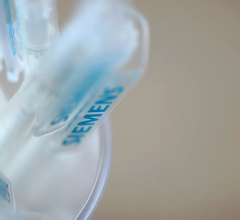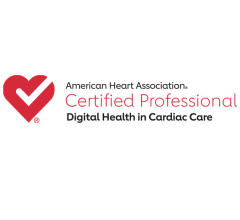
New York City newspaper headlines from April 1, 2020, and masked police officers at a subway station in Manhattan clearly outline the issues facing the city's hospitals during the height of COVID-19 pandemic in New York. Photo by Mike Borchardt.
Over the past three months COVID-19 has dominated nearly all healthcare news, so it is not surprising that the virus highlighted the opening sessions of the Society for Cardiovascular Angiography and Interventions (SCAI) Scientific Sessions 2020 Virtual Conference, May 14-16, 2020. Numerous speakers from the U.S., Italy and China presented, but one of the most compelling was how Columbia University Irving Medical Center in New York City weathered an overwhelming number of COVID-19 cases.
Ajay J. Kirtane, M.D., associate professor of medicine at Columbia University Irving Medical Center and director of the cardiac catheterization laboratories at NewYork-Presbyterian Hospital, shared his experiences with preparing for the the expected tsunami of COVID-19 (SARS-CoV-2) cases and what happened during the height of the crisis. He offered several takeaway messages for cardiologists.
Preparing New York Hospitals to be Overwhelmed by COVID Patients
“Until things hit close to home, we really had no idea what we were in for,” Kirtane said. “None of us could really have predicted how this would happen or how we could ever prepare for it.”
Kirtane said hospitals in New York watched events unfold very closely in Italy and spoke with colleagues there to find out what has happening in their hospitals and cases they had seen. Doctors in Italy told Kirtane it was much worse than the flu. Kirtane said the statistics gathered from the spread and infection rate in Italy were used for projections for possible impacts of COVID on New York City.
“When we saw the projections of available hospital beds and what we were expected to need when we hit the peak, most of us reached freak-out mode and we needed to move constructively from that emotion to figure out what we needed to do to increase our capacity to accommodate that peak,” Kirtane stated.
He said health officials and the area hospitals determined the curve needed to be flattened as much as possible to avoid overwhelming the hospitals, so the city was largely shut down to aid containment efforts. Kirtane said Columbia postponed all elective procedures starting March 16.
“We needed to allow the hospital to be able to handle this influx of patient volume that was going to come and to preserve PPE (personal protective equipment), because specifically in the New York area, there was a real shortage,” he explained. “Also, there simply would not have been any hospital beds available if these precautions were not taken."
Even with these measures, many New York hospitals were hit very hard, he said.
“When people see pictures and they say that isn't real, I assure you it was definitely real and it was horrific,” Kirtane explained. “We were simply overrun. We did not have enough PPE, and there were hospitals where nurses were actually wearing garbage bags. These are true stories. There was rationing of PPE, there were not enough N95 or even surgical masks to go around. Our hospital was overrun by COVID cases, where almost 90 percent of our patient volume was COVID only, so we had no room to accommodate any other disease processes in the hospital had we continued to operate business as usual.”
Kirtane said many areas of the country have not experienced this, but he asserted that without measures to curtail non-essential procedures, there would have been no capacity left to care for COVID patients in New York City.
Overwhelmed Emergency Departments and Collateral Damage Due to No ED Capacity
Kirtane said there was so much focus on COVID cases, some hospitals became difficult to access for non-COVID emergency patients. Many emergency departments (ED) were overwhelmed by COVID cases and other patients suffered, including heart attack patients. He said several EDs in New York City were so swamped by COVID patients that it greatly slowed patients with other acute medical conditions from getting access to timely care. In his SCAI presentation, Kirtane showed a text message he received from a friend when his father was dying, which turned out to be from a non-COVID cause. However, the hospital he went to could not respond to the patient in time to save his life.
He said hospitals need to keep this in mind when considering reopening areas under containment and preparing for the expected surge in new COVID cases this fall. This includes plans for expanding ED capacity to be able to handle all patients who require care and creating a stockpile of PPE.
He said fear of COVID also prevented some heart attack patients from seeking medical attention. “Because patients were afraid to go to the hospital, we saw virtually no STEMIs (ST-elevated myocardial infarction), acute coronary syndromes (ACS) or non-STEMIs,” Kirtane said.
"Even if we are going to see repeated surges, we need to be able to make sure we can not only take care of COVID, but also be able to take care of the other things. In order to do that, we need to not only be able to expend capacity and PPE stores, but also somehow be able to control the amount of infections we get, because the growth being so exponential that once you get be behind it is not something you are going to be able to get a handle on," he explained.
COVID-19 Impact on Cardiovascular Procedures in New York City
Cardiology triaged its patients to determine if they needed immediate procedures, or if they could be stabilized and wait a few weeks until after the COVID peak had passed. Kirtane said there was a sudden and significant drop in ST-elevated myocardial infarction (STEMI) heart attacks and the vast majority of other cases were postponed.
“We went nearly three weeks where we had not done any non-STEMIs and we did very few TAVRs, only a few cases where patients were in very dire circumstances. We did minimal to no cardiothoracic surgeries, except for aortic dissections and emergent CABG. We only did immediate post transplant biopsies, because we needed to know how to manage them. All of our ICUs became entirely filled with just COVID patients. There were no other diseases in these ICUs for the most part, and that was remarkable, since we worked to double ICU capacity at our hospital. Telemedicine was also ramped up.”
Cardiology was also called on to help many COVID patients. COVID patients with comorbidities were much more likely to have severe symptoms requiring hospitalization, but patients with pre-existing cardiovascular diseases suffer the highest mortality rate of all COVID patients. COVID in some cases also causes acute heart failure, myocarditis, shock, thromboembolism and the drugs being used to treat the virus can compound cardiac issues by causing arrhythmias.
COVID-19 Lessons For Cardiologists
Kirtane had several takeaways from this experience that cardiologists should be aware of to better prepare for possible COVID surges. These include:
• Know your pulmonary and ICU medicine, because these aspects play key roles in managing COVID patients that require cardiology assistance.
• Understand the range of type II presentations of myocardial infection (MI), myocarditis, myopericarditis and shock states, as these all have shown up in COVID patients.
• Understand arrhythmias that occur in these patients, especially QT-prolongation because several of the drugs (e.g. hydroxchloroquine and azithromycin) being used to treat COVID cause this.
• Patients with cardiac manifestations were some of the sickest, with multi-organ issues including renal failure. “It was luck in some respects if it was only the lungs in some patients, because they tended to recover better,” Kirtane said.
• Hemodynamic support in COVID patients is required mostly because of oxygenation issues. There have been reports of ECMO or other types of hemodynamic support being required, but most of the issues in COVID are due to vasodilitory issues, so Columbia found lower levels of support were generally sufficient.
• Work out plans for transitions in care to avoid infection risks with staff and other patients. This includes separating COVID from non-COVID patients.
• Watch for COVID patients with ECGs that mimic STEMI. These patients often get to the cath lab and their coronary arteries are open with no need to revascularize.
Use of Fibrinolytic Therapy Instead of PCI in Heart Attack Patients
Columbia developed a protocol to use fibrinolytic therapy as an alternative to percutaneous intervention (PCI) in COVID-19 patients as a backup plan in case things got really bad in New York. The plan gained national headlines, since it suggested moving back to the obsolete standard-of-care from more than 30 years ago, before PCI performed in cath labs became common.
However, Kirtane said Columbia never needed to implement this plan and never treated a singled patient using lytics only.
He said the protocol, which has since been suggested as an emergency course of action in the SCAI guidelines for treating heart attack patients under the COVID-19 pandemic, was developed for hospitals that did not have a cath lab and had issues transferring patients, or if there was a dire shortage of PPE where it was not safe for staff to treat the patient in the cath lab, or there was a surge and no hospital beds available.
As COVID Cases Decline, Cardiology Programs Rebooting
As COVID cases go down, hospitals are attempting to reboot their cardiology programs to get patient case volumes back to normal. However, experts say it will be a slow process as departments continue to triage cardiology patients to treat the most severe cases first. Cardiology still needs to be mindful of PPE and taking extra time to ensure more stringent infection control measures.
"We are about halfway back to our normal volume. We are working really hard to bring that back up, but keeping our staff health is the number one priority, and ensuring out patients are getting the best possible care," explained Roxana Mehran, M.D., director of interventional cardiovascular research and clinical trials at the Zena and Michael A. Wiener Cardiovascular Institute at Mount Sinai School of Medicine, Mount Sinai Medical Center, speaking in the SCAI virtual sessions.
"We still have about 250 COVID patients in our hospital, so it is still a pretty active area," she said. "I was in the wards last week and saw the brunt of venous thrombo-emolism (VTE) and some of the thrombotic complications of this incredible virus. They say this is a respiratory virus, but it attacks pretty much every other organ system — the kidneys, the brain, and most importantly the heart. So, we all need to learn how to take care of COVID patients. I expect we will be seeing the cardiovascular events in these patients coming later down the pike."
New York City Will Rise Again From the COVID-19 Pandemic
Fortune ended his presentation with a photo of the Freedom Tower of the World Trade Center complex in New York City, built to replace the twin towers destroyed in the September 11, 2001, terror attacks. “We have been through a lot of things in New York in the past and 9/11 certainly was something we recovered from, and I am certain that after this virus we will emerge stronger than ever. That is what New Yorkers do, that's who we are. But, I can't say we haven't been hurt to our core by this. We have been overrun, but we will rise again," Kirtane concluded.
Hear more about Columbia's response and details on some of the patient cases in the VIDEO: Multiple Cardiovascular Presentations of COVID-19 in New York.
Read the article New York City Physicians Note Multiple Cardiovascular Presentations of COVID-19.
Related COVID-19 Cardiology Content:
American College of Cardiology Registries Collect COVID-19 Data
VIDEO: CT and POCUS Emerge As Frontline Cardiac Imaging Modalities in COVID-19 Era
ACC COVID-19 recommendations for the cardiovascular care team
VIDEO: Imaging COVID-19 With Point-of-Care Ultrasound (POCUS)
Cardiac Imaging Best Practices During the COVID-19 Pandemic
VIDEO: COVID-19 Precautions for Cardiac Imaging — Interview with Stephen Bloom, M.D.
VIDEO: Best Practices for Nuclear Cardiology During the COVID-19 Pandemic — Interview with Hicham Skali, M.D.
New Research Highlights Blood Clot Dangers of COVID-19
Survey Reveals Most Medical Practices are Now Using Telehealth Due to COVID-19
VIDEO: What Cardiologists Need to Know about COVID-19 — Interview with Thomas Maddox, M.D.
The Cardiac Implications of Novel Coronavirus


 November 14, 2025
November 14, 2025 









